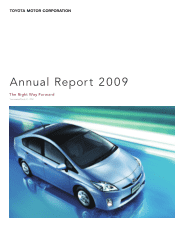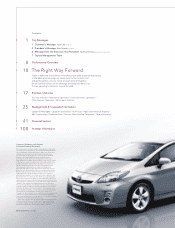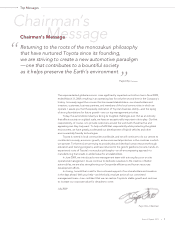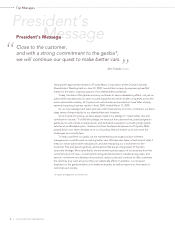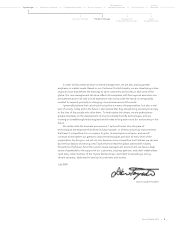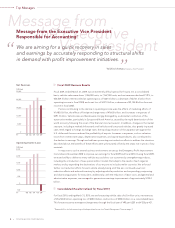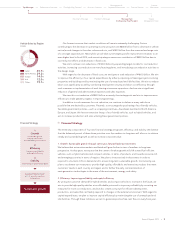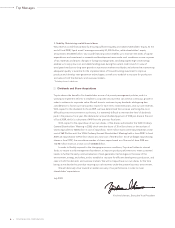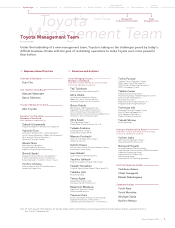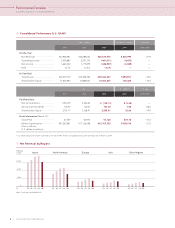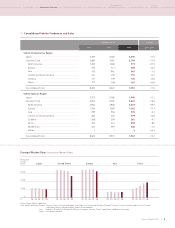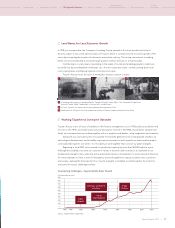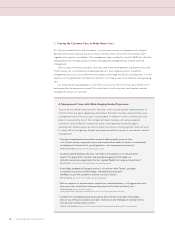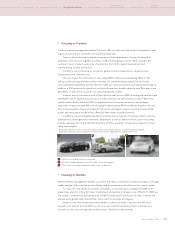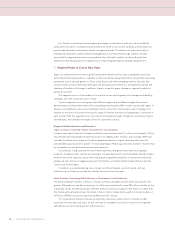Toyota 2009 Annual Report Download - page 7
Download and view the complete annual report
Please find page 7 of the 2009 Toyota annual report below. You can navigate through the pages in the report by either clicking on the pages listed below, or by using the keyword search tool below to find specific information within the annual report.
Vehicle Sales by Region
FY2009
Japan 25.7%
North America 29.2%
Europe 14.0%
Asia 12.0%
Others 19.1%
Financial Strategy
1
Growth
Sustainable growth
through continuous
forward-looking investments
2
Efficiency
Improving profitability
and capital efficiency
3
Stability
Maintaining a solid financial base
Balanced implementation
of 1.–3. over the medium-
to-long term
Sustainable growth
Our forecast assumes that market conditions will remain extremely challenging. Factors
contributing to the decrease in operating income prospects are ¥800.0 billion from a decrease in vehicle
unit sales and changes in the sales volume and mix, and ¥450.0 billion from the assumed exchange rate
of a stronger Japanese yen. Meanwhile, we will take our emergency profit improvement initiatives to an
even higher level in fiscal 2010, and are anticipating an enormous contribution of ¥800.0 billion due to
cost reduction efforts and decreases in fixed costs.
We aim to achieve cost reductions of ¥340.0 billion by expanding target models for cost reduction
activities, increasing cost reductions at manufacturing plants, and introducing cost reduction activities at
the design stage.
With regard to the decrease of fixed costs, we anticipate a total reduction of ¥460.0 billion. We aim
to improve the efficiency of our capital expenditures by either postponing or freezing projects involving
properties and buildings and by maximizing the use of unemployed and idle facilities. We aim to reduce
labor costs significantly as well by combining employment security and labor cost efficiency through
such measures as implementation of work sharing at overseas operations. And we aim at significant
reduction of general and administrative expenses and sales expenses.
We view this cost reduction of ¥800.0 billion as merely the starting point and aim to improve more
efficiency to make greater progress in improving earnings.
In addition to such measures for cost reduction, we continue to deliver as many vehicles as
possible that are desired by customers. Recently, to encourage the purchasing of eco-friendly vehicles,
favorable government policies—such as scrapping incentives—have been launched in North America,
Europe, and Japan. We have an extensive lineup of eco-friendly vehicles, such as hybrid vehicles, and
aim to increase production and sales utilizing these government policies.
Financial Strategy
The three key components of Toyota’s financial strategy are growth, efficiency, and stability. We believe
that the balanced pursuit of these three priorities over the medium-to-long term will allow us to achieve
steady and sustainable growth as well as increase corporate value.
1. Growth: Sustainable growth through continuous forward-looking investments
We believe that automotive markets worldwide will grow further in view of medium-to-long term
perspective. As they grow, we expect that the center of market growth will shift toward fuel-efficient
vehicles, such as hybrid vehicles and compact vehicles, in terms of products, and towards resource-rich
and emerging countries in terms of regions. We plan to invest actively in these areas in order to
respond to structural shifts in demand and to ensure long-term sustainable growth. Concurrently, we
plan to accelerate our measures to provide high-quality, affordable, and attractive products that meet
customers’ needs in each country and region and to further the early commercialization of
next-generation technologies in the areas of the environment, energy, and safety.
2. Efficiency: Improving profitability and capital efficiency
As we expect customer demand for hybrid vehicles and compact vehicles to increase in the future, we
aim to provide high-quality vehicles at an affordable price and to improve profitability by accreting our
measures for more cost reductions. And we also create a structure for efficient development,
production, and sales that can flexibly respond to changes in the external environment. With regard to
capital expenditures, we plan to improve capital efficiency by maximizing the use of unemployed and
idle facilities. Through these initiatives, we aim to generate positive free cash flows in every fiscal year.
The Right Way Forward Business OverviewPerformance Overview Financial Section
Investor
Information
Management &
Corporate Information
Top Messages
Chairman’s Message Toyota
Management Team
Message from
the Executive Vice President
President’s Message
Annual Report 2009 5

